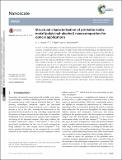Files in this item
Structural characterisation of printable noble metal/poly(vinyl-alcohol) nanocomposites for optical applications
Item metadata
| dc.contributor.author | Hourd, Andrew | |
| dc.contributor.author | Baker, Richard T. | |
| dc.contributor.author | Abdolvand, Amin | |
| dc.date.accessioned | 2015-11-13T14:40:05Z | |
| dc.date.available | 2015-11-13T14:40:05Z | |
| dc.date.issued | 2015-08-28 | |
| dc.identifier | 204853064 | |
| dc.identifier | c13e60a2-47a1-4ab3-a274-1e1ee1ef9f9e | |
| dc.identifier | 84938892372 | |
| dc.identifier | 000359234100030 | |
| dc.identifier.citation | Hourd , A , Baker , R T & Abdolvand , A 2015 , ' Structural characterisation of printable noble metal/poly(vinyl-alcohol) nanocomposites for optical applications ' , Nanoscale , vol. 7 , no. 32 , pp. 13537-13546 . https://doi.org/10.1039/C5NR03636D | en |
| dc.identifier.issn | 2040-3364 | |
| dc.identifier.other | ORCID: /0000-0002-3304-3280/work/59464822 | |
| dc.identifier.uri | https://hdl.handle.net/10023/7782 | |
| dc.description | This work was conducted under the aegis of the Engineering and Physical Sciences Research Council (EPSRC) of the United Kingdom (EP/I004173/1). Amin Abdolvand is an EPSRC Career Acceleration Fellow at the University of Dundee. | en |
| dc.description.abstract | In order to enable exploitation of noble metal/poly(vinyl-alcohol) nanocomposites for device fabrication, solutions of poly(vinyl-alcohol) suitable for piezo-driven inkjet printing techniques are identified and discussed in terms of their material properties. The printable poly(vinyl-alcohol) medium is then exploited as a host material through the formation of silver or gold nanoparticles in order to create nanocomposites that exhibit a surface plasmon resonance behaviour associated with the small metallic inclusions. To mitigate some of the material redistribution effects associated with the drying of printed droplets containing finely divided materials, the metallic nanoparticles are formed after the printing and drying process is completed, by way of an in-situ reduction of an appropriate metal salt by the poly(vinyl-alcohol)-host matrix itself, which takes place at modest temperatures compatible with most substrate materials. An obvious application for such nanocomposites is in optical elements whereby the surface plasmon resonance associated with the metal is the functional aspect of devices such as sensors or active optical elements. High Resolution Transmission Electron Microscopy was used to examine the dimensions, distribution, morphology and crystal structure of the silver and gold nanoparticles in detail allowing discussion of their suitability for these applications and what further optimisation may be necessary to adequately control their formation. | |
| dc.format.extent | 10 | |
| dc.format.extent | 9936008 | |
| dc.language.iso | eng | |
| dc.relation.ispartof | Nanoscale | en |
| dc.subject | QD Chemistry | en |
| dc.subject | DAS | en |
| dc.subject | BDC | en |
| dc.subject.lcc | QD | en |
| dc.title | Structural characterisation of printable noble metal/poly(vinyl-alcohol) nanocomposites for optical applications | en |
| dc.type | Journal article | en |
| dc.contributor.institution | University of St Andrews. School of Chemistry | en |
| dc.contributor.institution | University of St Andrews. St Andrews Sustainability Institute | en |
| dc.contributor.institution | University of St Andrews. EaSTCHEM | en |
| dc.identifier.doi | 10.1039/C5NR03636D | |
| dc.description.status | Peer reviewed | en |
This item appears in the following Collection(s)
Items in the St Andrews Research Repository are protected by copyright, with all rights reserved, unless otherwise indicated.

